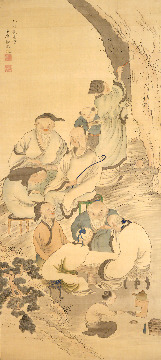AOKI Shukuya (?-1802)
The Four Accomplishments
(Playing the zither, playing the game of weiqi, calligraphy, and painting)
1795
Chinese ink and tint on paper
114.8 × 51.7 cm
During the Edo Period, the famous humorist, playwright, and author Ota Nanpo (1749-1823) was once invited to the estate of a certain feudal lord. That day, the lord was hosting a feast. The guests sat along a stream, and a sake cup was placed on the water so that it would float downstream. The guests were instructed to compose a poem before the cup floated by, and if they could not do it, they had to take a drink in penance. The idea for this gathering came from the famous story, The Meandering Stream at Lanting written by Wang Xizhi in eastern China during the Jin dynasty. It is said that the event Ota Nanpo attended even featured musical performances by musicians dressed in Chinese-style robes.
This story may surprise some contemporary readers because many people today think of Edo-period Japan as completely isolated from the outside world. People in the Edo period were, in fact, fascinated with foreign countries like China, and foreign culture had a large impact on Japanese society.
This painting attests to the popular fascination with China during the Edo period. The subject of the painting is the "four accomplishments." Since ancient times, the Chinese have believed all gentlemen of cultural breeding should have some interest in the qin (a type of zither called koto in Japanese), the game of weiqi (known as igo or go in Japan), calligraphy, and painting. In this painting, one can see a man writing on a rock wall, a man playing the qin to a small audience, and several people playing weiqi. We do not see anyone painting in the work itself, but this absence reveals a clever twist on the artist's part. Instead of painting a person painting a picture, the artist has presented us with the fruit of this endeavor. In other words, this painting is the painting men of breeding are to appreciate.
-- Yamaguchi Yasuhiro

